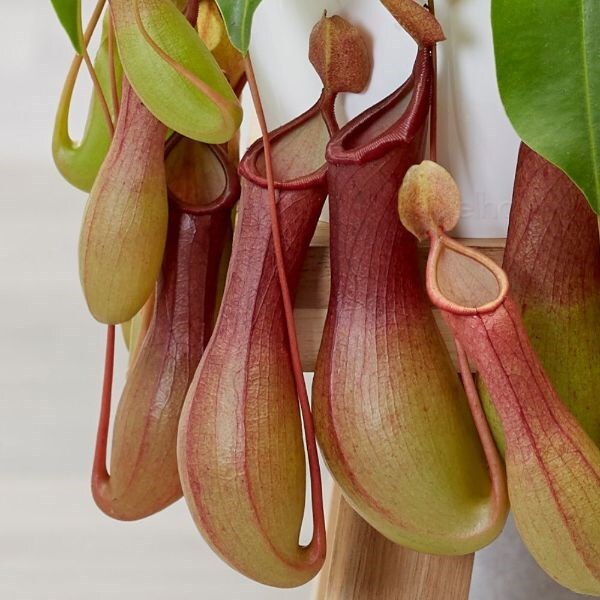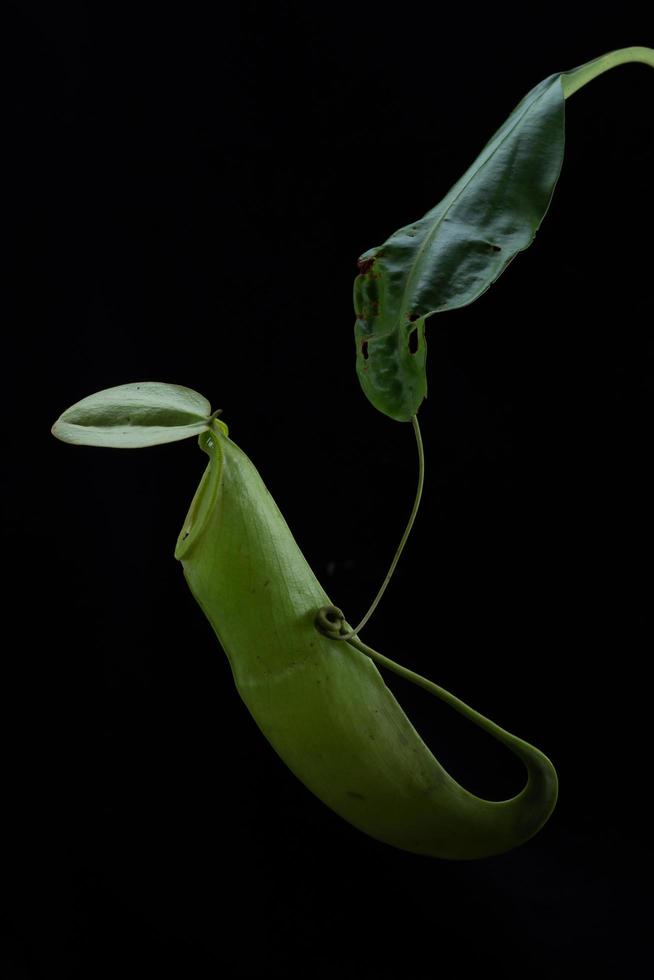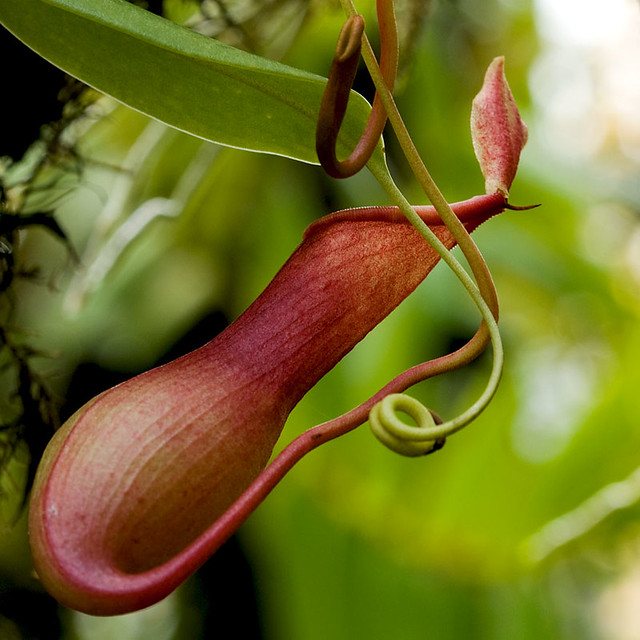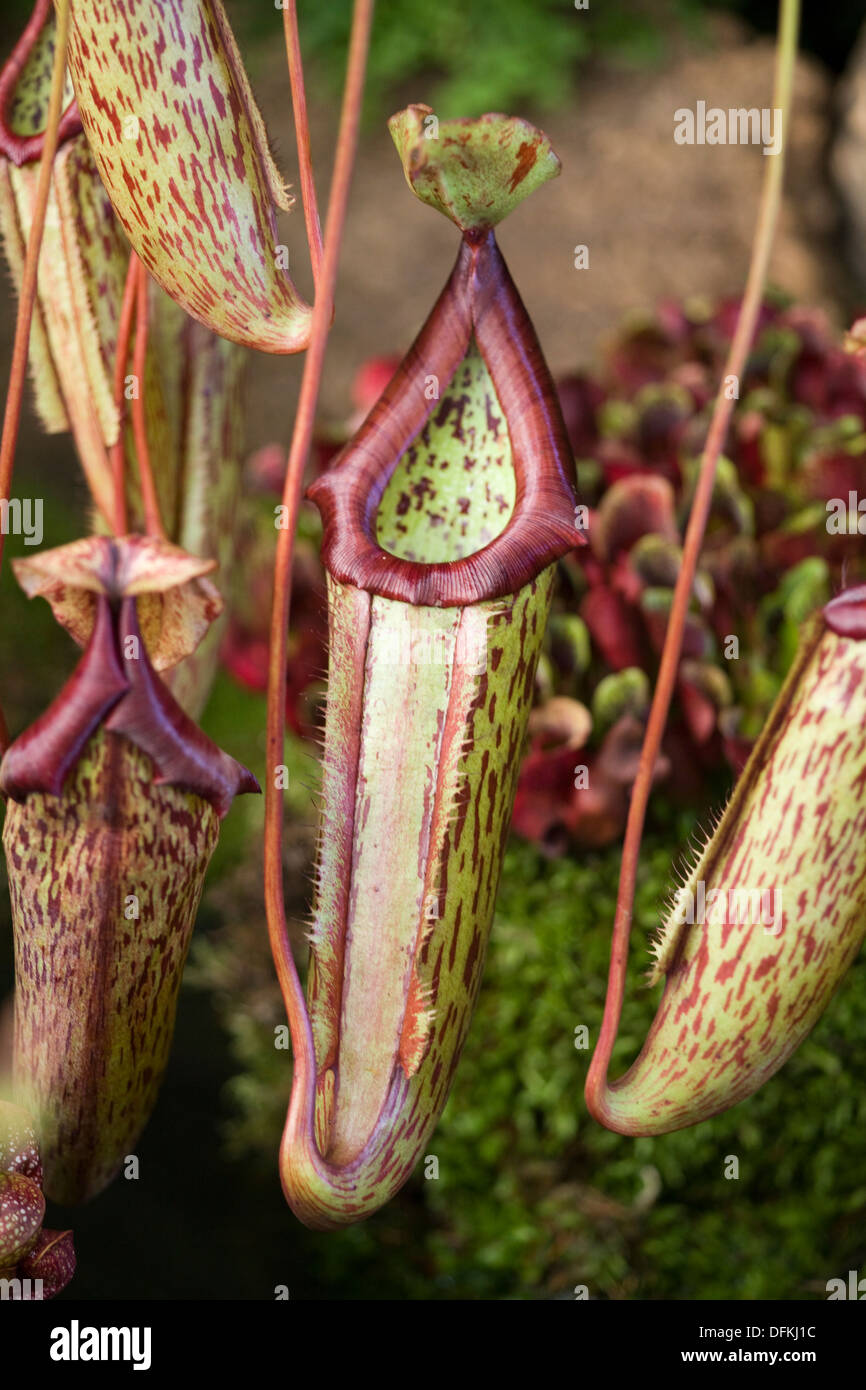
Monkey Cups Nepenthes sp. 9566119 Stock Photo at Vecteezy
Nepenthes, which is often called the monkey cup or tropical pitcher plant, is rather exotic looking. From its tendrils you'll see globe- or tube-shaped protrusions that act as traps. In the tropics, monkeys are often seen drinking rainwater from these "pitchers" which is how it got its most popular nicknames.

Nepenthes Plant,monkey Cups Stock Image Image of catch, flesh 99559089
Monkey cups are known as Nepenthes in the plant world. It is a vine-like plant with pitchers hanging from the ends of its greenish leaves. Pitchers are produced as the leaf's midvein swells. This creates a hollow cup with a liquid-filled bottom. Because of its stunning hues and the nectar it secretes, insects are drawn to this plant.

Nepenthes or Monkey Cups stock photo. Image of ampullaria 154931096
Monkey Cups are a species of carnivorous plants native to Southeast Asia, Australia, Madagascar, and the Philippines. Although they may look similar to other pitcher plants, it's actually the largest genus in their family. There are more than 130 known species of Nepenthes.

Nepenthes or Monkey Cups in Field Stock Photo Image of pitcher
One of the best-known is a fun plant called Monkey Cups, or Asian Pitcher Plant ( Nepenthes) that can be grown in a hanging pot as a houseplant. Most species of Monkey Cups are tropical vines that climb up trees, but some species stay on the ground.

Nepenthes or Monkey Cups in Field Stock Image Image of flora, floral
Nepenthes are also nicknamed tropical pitcher plants and monkey cups. It is a viney plant having greenish leaves with pitchers hanging from the ends of the leaves. Pitchers are created by the swelling of the mid-vein in the leaf. This forms a hollow cup filled with fluid at the bottom.

Nepenthes Spp. "Monkey Cups" Care Guide Terrarium Plants
Nepenthes - also known as tropical pitcher plants or monkey cups - have been inspiring awe in botanists since they were first discovered by Europeans in the 17th century. With their dazzling colours and elaborately decorative traps, the plants seem to flaunt their carnivory with pride.

Nepenthes (monkey cups) stock image. Image of plant, dangerous 27957827
TRAP TYPE: Pitfall Trap Currently 90 listed species occupying tropical habitats in Australia, Madagascar, Papua New Guinea, the Seychelles, Southeast Asia and Sri Lanka.Nepenthes, a native of Southeast Asia and Australia, forms pitchers (cups) that hang from trees.Its pitcher is similar to that of the North American pitcher plant in that it relies on a pool of water to trap its prey.

Buy pitcher plant / monkey cups Nepenthes '× ventricosa'
0.8 cups. every 7 days. monkey cup needs 0.8 cups of water every 7 days when it doesn't get direct sunlight and is potted in a 5.0" pot. Use our water calculator to personalize watering recommendations to your environment or download Greg for more advanced recommendations for all of your plants. Water 0.8 cups every.

Monkey Cups Nepenthes sp. 9565321 Stock Photo at Vecteezy
With their unique and unusual leaf morphology, Nepenthes (colloquially known as 'monkey-cups') arearguably some of the Earth's most beautiful carnivorous plants. The main stronghold of this genus is South-East Asia, with some of the most commonly available species coming from the islands of Borneo, Sumatra and numerous islands of the Philippines.

Nepenthes Monkey Cups (Pitcher Plant)
Nepenthes are tropical pitcher plants native to parts of South East Asia, India, Madagascar and Australia. Most are vines, but some remain compact in habit. The name "Monkey Cups" comes from monkeys occasionally drinking the fluid in the pitchers. The pitcher is actually a swelling of the mid-vein in the leaf.

Nepenthes (monkey cups) stock image. Image of green, nepenthe 27962795
Pitcher plant: flower, origin, and characteristics. The tropical pitcher plant (Nepenthes), also known as the monkey jar plant or monkey cup plant, is the only genus in the pitcher plant family (Nepenthaceae).To date, more than 100 different species are known, some of which grow as semi-shrubs and others look like vines that cling to other plants with their tendrils.

Nepenthes (Monkey Cups) Advanced 10cm Plantsmith Indoor Plants
These are popularly known as 'Pitcher Plants' or the 'Monkey Cups'. The name Monkey Cups refers to the interesting myths that monkeys used to drink water from these plants. Howbeit, this is a fake story because the pitchers are filled up with digestive juices and not water. Nepenthes was first discovered in Europe, in the 17 th century.
-385-p.jpg?v=962ce7ed-d45c-4c95-8fa5-b75ff6e0c70c)
Nepenthes 'Bloody Mary' small Nepenthes Monkey Cup
Nepenthes - Monkey Cup Plants Nepenthes × ventrata (Interspecific hybrid between N. alata & N. ventrata ). Contents Introduction Top Tips Location, Water, Humidity & Fertilisation Dormancy Care Common Issues Origins, Temperature, Propagation, Repotting & Toxicity. Need the answer to a specific plant query?

Monkey cup The cool Nepenthes Monkey Cups found it inside … Flickr
Nepenthes ( / nɪˈpɛnθiːz /) is a genus of carnivorous plants, also known as tropical pitcher plants, or monkey cups, in the monotypic family Nepenthaceae. The genus includes about 170 species, [4] and numerous natural and many cultivated hybrids.

Monkey Cups Nepenthes sp. 9565858 Stock Photo at Vecteezy
Scientific Names: Nepenthes Synonyms: Monkey Cups , Tropical Pitcher Plant, Pitcher Plant The Asian Pitcher Plant, or Tropical Pitcher Plant or Nepenthes, can be found in its natural habitat in the tropical regions of Asia - mainly Thailand, Malaysia, Philippines, Indonesia, Singapore and New Guinea.

Nepenthes x mixta Monkey Cup Tropical alpine Plant on display Stock
Promoting conservation through cultivation since 1989! For over 30 years, we have grown and sold the widest variety of carnivorous plants in the United States. Venus flytraps, American pitcher plants, sundews, butterworts, bladderworts, tropical pitcher plants and others - all commercially cultivated for either the curious beginner or the.